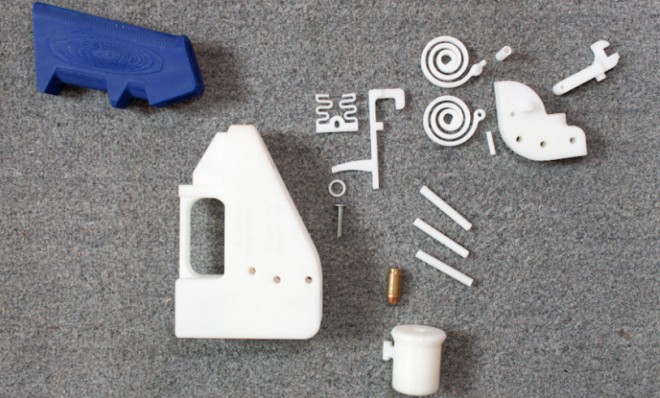Everything you need to know about the world's first 3D-printed handgun
Meet "The Liberator"

Recently, at an unnamed Texas firing range, the trigger of the world's first-ever 3D-printed handgun was pulled. The gun — nicknamed "the Liberator" — is made entirely out of plastic, save for a common hardware store nail used as a firing pin. And now, the Liberator's design is available for anyone to download for free. Here's what you should know:
How does it work?
Just like a regular handgun, except it's 99 percent plastic. According to Forbes' Andy Greenberg, who was on hand at the gun's inaugural firing, the plastic gun was made in just four hours using an $8,000 Stratasys Dimension SST 3D printer. The gun was "printed" layer-by-layer from melted plastic. (Read our primer on 3D printers here.)
The Week
Escape your echo chamber. Get the facts behind the news, plus analysis from multiple perspectives.

Sign up for The Week's Free Newsletters
From our morning news briefing to a weekly Good News Newsletter, get the best of The Week delivered directly to your inbox.
From our morning news briefing to a weekly Good News Newsletter, get the best of The Week delivered directly to your inbox.
The Liberator is made from 16 different parts — the firing pin is the only part that isn't printed and plastic — that must be assembled after printing. Unlike other handguns, it can only fire a single bullet at a time, and the detachable barrel wears out quickly. (The gun's creators note that you can always print a new one.) Here's the handgun in action, via The Verge:
Why is it called the Liberator?
It's an ode to the single-shot Liberator pistols "designed to be air-dropped by the Allies over France during its Nazi occupation in World War II," says Greenberg.
Who created it?
A free daily email with the biggest news stories of the day – and the best features from TheWeek.com
Cody Wilson, a 25-year-old law student at the University of Texas and a "radical libertarian and anarchist." Wired labeled him one of the 15 most dangerous people in the world.
Wilson and his start-up, Defense Distributed, were the subject of a recent Vice documentary called Click, Print, Gun, which detailed the creation of fully functional, 3D-printed assault rifle parts. The initiative, as Wilson sees it, is meant to spotlight "the futility of gun regulation."
"You can print a lethal device. It's kind of scary, but that's what we're aiming to show," Wilson tells Forbes. "Anywhere there's a computer and an Internet connection, there would be the promise of a gun."
How are Wilson's guns designed?
They're created in AutoCAD, a popular software application used to render 3D objects. The format is widely used in a number of industries, including engineering and architecture. Websites like Thingiverse house all kinds of files for anyone with a 3D printer to download. You can use them to make anything from toys to iPhone cases to furniture. (Defense Distributed was started when Wilson's listing for an AR-15 lower chamber was pulled by Thingiverse's moderators.) The Liberator's CAD files are available here.
But not many people have 3D printers, right?
Correct. But that's not stopping Defense Distributed. The company says that "desktop 3D printing technology is much like desktop printing in the early 80's. Innovation and demand will drive down barriers to entry to the technology over time. This project itself may have a tiny part in doing that." The next step for Wilson and his team is to design a handgun that can easily be put together from cheaper 3D printers, like MakerBot's $2,200 Replicator 2.
What do lawmakers say?
Rep. Steve Israel (D-N.Y.) responded to Defense Distributed's announcement by calling for a revamp of the Undetectable Firearms Act to clearly outlaw printed guns like the Liberator that are untraceable by a metal detector. On Sunday, Sen. Charles Schumer (D-N.Y.) similarly called for new legislation to ban 3D-printable handguns: "A terrorist, someone who's mentally ill, a spousal abuser, a felon can essentially open a gun factory in their garage," Schumer said.
Wilson denies that he's advocating violence. Rather, he says his aim is to show how technology — in this case, the free distribution of ready-to-download CAD files — can quickly render existing laws irrelevant. "I recognize that this tool might be used to harm people. That's what it is: It's a gun," Wilson tells Forbes. "But I don't think that's a reason to not put it out there. I think that liberty in the end is a better interest."
-
 Pakistan: Trump’s ‘favourite field marshal’ takes charge
Pakistan: Trump’s ‘favourite field marshal’ takes chargeIn the Spotlight Asim Munir’s control over all three branches of Pakistan’s military gives him ‘sweeping powers’ – and almost unlimited freedom to use them
-
 Codeword: December 6, 2025
Codeword: December 6, 2025The daily codeword puzzle from The Week
-
 Sudoku hard: December 6, 2025
Sudoku hard: December 6, 2025The daily hard sudoku puzzle from The Week